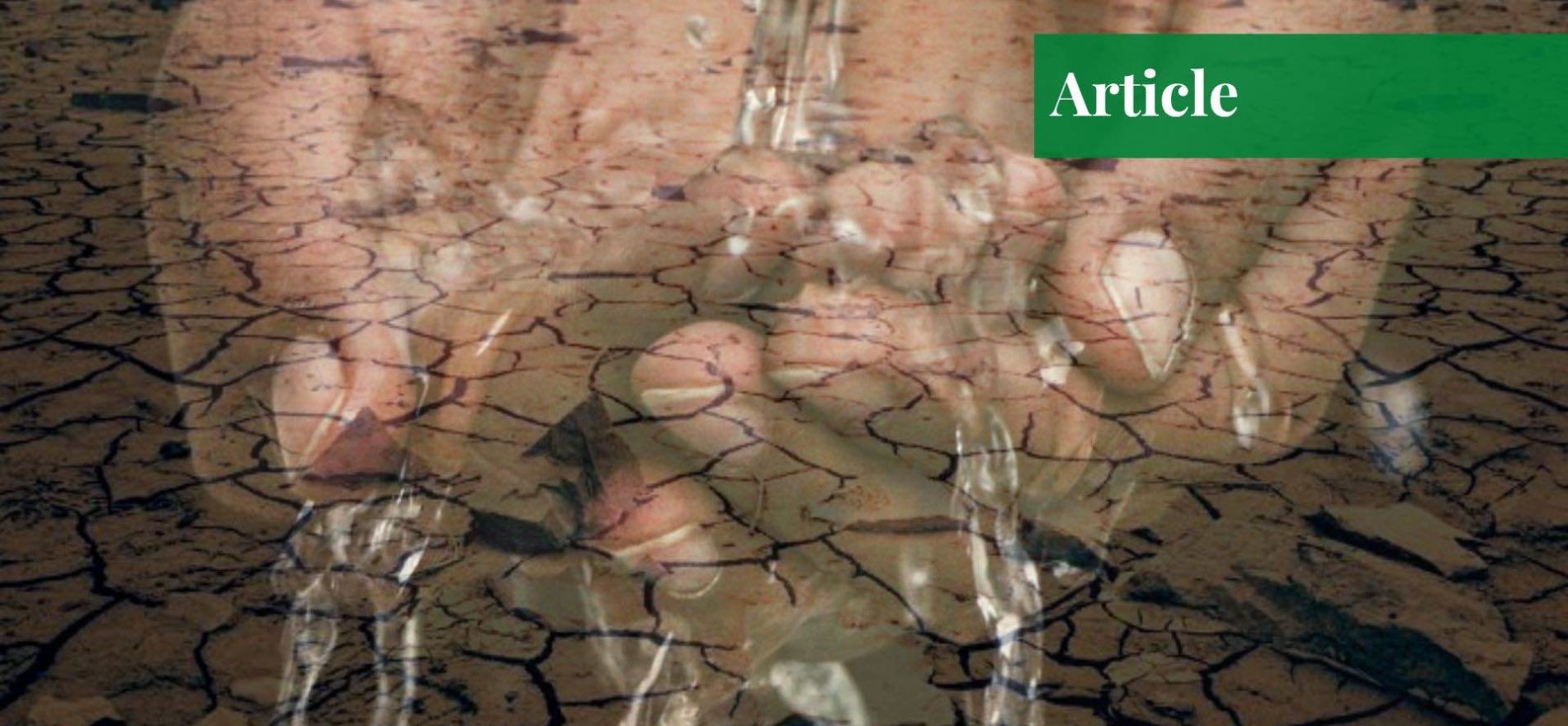Ms Afifa Iqbal has a keen interest in identity politics, colonialism and post-colonial development. She is currently working as a Research Assistant at ITU while pursuing her postgraduate studies in Development, Technology and Policy. She is a Gold Medalist in Political Science from the University of Punjab.
Introduction
Images of dehydrated children and dead animals with protruding tongues lined up on the desert floor highlight the gravity of the water crisis faced by Cholistan. It is one of the most water-stressed regions in the country. For years, climate activists and independent researchers have cried hoarse that a coherent and long-term water policy is needed to deal with the impending water crisis in Pakistan – with little to no attention from the government.
Even during the current crisis, individual citizens and NGOs are doing more to help the residents than state officials. However, such individual efforts, without targeted government interventions, will be unsustainable and reactive. These efforts have to be complemented by the public officials’ actions if this crisis is to be addressed.
The Place We Call Cholistan
Cholistan, or Rohi, comprises the western part of the Thar Desert and spans across Bahawalpur, Rahim Yar Khan, and Bahawalnagar districts. Known for its iconic Derawar Fort, the desert is home to many other medieval forts.

Tim William’s thematic study on Silk Roads for International Council on Monuments and Sites talks about the “corridor of movement and impact” and these medieval forts of the Cholistan desert are a part of that corridor as acknowledged by UNESCO. Cholistan was not always a desert; instead, it was part of the thriving Indus Valley civilization.
As UNESCO notes; “There is archaeological evidence that this area was once watered by the Hakra River and was home to an Indus Valley culture based on agriculture. This river, the bed of which can be seen clearly etched into the desert landscape, supported settlements from ca. 4000 BC until around 600 B.C. when the river changed its flow and subsequently vanished underground. Since then the Cholistan area has been a stark and inhospitable desert environment at the edge of empires.”
Today, Cholistan is home to approximately 1.2 million people (some relatively recent studies estimate it at around 1,55,000) with a nomadic-pastoral lifestyle apropos of extremely hot climate and arid land.
A 1996 study has described this nomadic-pastoral lifestyle: “The pastoral system is characterized by mass migrations of animals and people throughout the year in search of water and forage. The onset of monsoon and the distribution of rainfall mainly dictate the pattern of movement of nomadic herders. Around the months of March or April, nomadic households move towards surrounding irrigated areas forced there by rising temperature in the desert and depleted feed and water resources.”
In other words, Cholistan is inhabited by people who are used to the harsh living conditions of the desert and to moving around in search of water and food. Hence, it is telling when the people of Cholistan are brought to their feet by this water crisis.
It is telling because these are not the urban dwellers who are used to having relatively reliable access to clean water; these are the people who know that water is a scarce commodity, and at times, the only line separating the living from the dead. So, when such people clamor about water shortage, attention must be paid.
Current Drought, Old Water Crisis
In the first half of May, the news broke out on Twitter and mainstream media about the dire conditions of Cholistan’s residents and the cattle brought about by drought. Various domestic publications reported that over 50 heads of cattle died due to water shortage.

The dying cattle (right before Eid-ul-Adha) threaten the livelihood of these people since most of them are pastoralists. Lack of rainfall, dry canals, and heatwave have been cited as the main reasons for the current water crisis in Cholistan. The residents, on the other hand, are mostly blaming the government for not releasing water into the canals.
Given the fact that Pakistan figures among the top 36 water-stressed countries, this should be considered as the unravelling of the looming water crisis. To add insult to injury, the Indus River System Authority claimed in its presentation to the National Assembly’s Standing Committee on Water Resources that the water shortage is expected to be around 38 percent.
To put the gravity of the situation into perspective, earlier, the water shortage was expected to be around 22 percent. This water shortage is specifically going to impact the crops of Punjab and Sindh which, in turn, will adversely impact food security. This, in turn, will only accentuate the water shortage faced by water-stressed regions such as Cholistan.
Is There Any Water at the Bottom of the Well?
The government did take notice of the drought in Cholistan. The Punjab Disaster Management Authority (PDMA), Punjab Emergency Service (Rescue 1122), and the Cholistan Development Authority (CDA) joined hands to salvage the situation.
According to Radio Pakistan, “Punjab Emergency Services Department (PESD) Bahawalpur has sent eight ambulances and nine water bowsers along with fifty-seven Rescuers for Cholistan. According to District Emergency Officer…Baqir Hussain six rescue posts have been established in the drought-hit areas which will provide first aid and awareness about heat wave to the people of Cholistan.”
In addition to the steps taken by the government, many citizen-led initiatives and NGOs have also kicked off the relief efforts. Shahid Afridi Foundation and Al-Khidmat Foundation, among others, constituted the relief efforts. The armed forces and some members of a religious-political party also made their foray into the relief efforts.
Although the temporary relief infrastructure has been set up by the government, it is the classical manifestation of “too little, too late” and pales in comparison to the efforts made by the citizens and civil organizations to raise awareness about the issue and initiate the relief efforts. These citizen-led initiatives, no matter how good, are bound to be temporary.
It is the duty of the government to take precautionary measures and set up permanent relief centres. Having stated that, the government can always harness the resources of these civil organizations for this purpose. This type of public-private partnership is neither new nor unimplementable for the bureaucracy.
A Prospect of Public-Private Partnerships
Recently, DC of central Karachi announced a partnership with various private organizations aimed at the development of central Karachi. He tweeted, “Congratulations to the people of District Central for today we have reached agreements with various stakeholders to develop our public amenities, parks, dispensaries and Schools under public-private partnership in the ambit of CSR activities.”
Now, even if such high-profile partnerships are difficult to broker for a region like Cholistan, low-profile public-private partnerships can still be made. Former AC Kuchlak Awaid Arshad Bhatti revealed during a podcast that he started 3 cost-effective and time-effective projects via public-private partnerships which yielded promising results.
With the help of the Taleem Foundation, he installed projectors in schools through which teachers in Islamabad can deliver lectures to the students in Kuchlak. He also converted an empty lot into a library with the help of the Akhuwat Foundation. In addition, he was also able to install a water filtration plant to ensure the supply of clean water for the residents. A public-private partnership, along these lines, can go a long way in solving the water crisis in Cholistan.
The current drought in Cholistan is neither the first nor the last one, given the ecology of the region, climate change, and water scarcity. It must be remembered that there will be such droughts in the future. The impact of such droughts can and should be managed by the government and in this regard, a public-private partnership can prove to be one of the first steps in the right direction.
If you want to submit your articles, research papers, and book reviews, please check the Submissions page.
The views and opinions expressed in this article/paper are the author’s own and do not necessarily reflect the editorial position of Paradigm Shift.



















